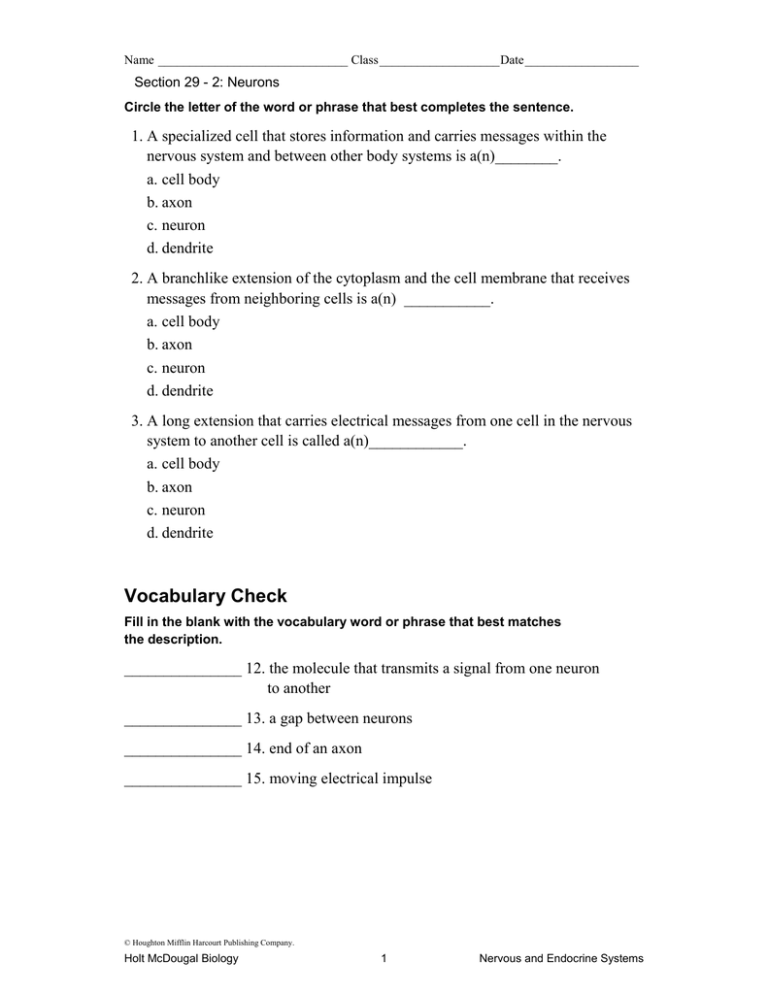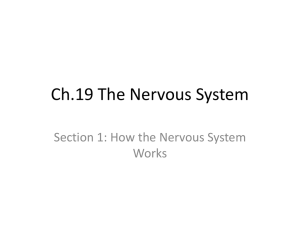29-2 study guide
advertisement

Name ______________________________ Class ___________________ Date __________________ Section 29 - 2: Neurons Circle the letter of the word or phrase that best completes the sentence. 1. A specialized cell that stores information and carries messages within the nervous system and between other body systems is a(n)________. a. cell body b. axon c. neuron d. dendrite 2. A branchlike extension of the cytoplasm and the cell membrane that receives messages from neighboring cells is a(n) ___________. a. cell body b. axon c. neuron d. dendrite 3. A long extension that carries electrical messages from one cell in the nervous system to another cell is called a(n)____________. a. cell body b. axon c. neuron d. dendrite Vocabulary Check Fill in the blank with the vocabulary word or phrase that best matches the description. _______________ 12. the molecule that transmits a signal from one neuron to another _______________ 13. a gap between neurons _______________ 14. end of an axon _______________ 15. moving electrical impulse © Houghton Mifflin Harcourt Publishing Company. Holt McDougal Biology 1 Nervous and Endocrine Systems Name ______________________________ Class ___________________ Date __________________ Study Guide A continued Fill in the blanks in the Concept Map with the names of the different types of neurons. Neurons types 4. 5. 6. function function function Detect stimuli; transmit signals to brain and spinal cord Make up brain and spinal cord; receive signals from sensory neurons Pass messages from nervous system to other body tissues MAIN IDEA: Neurons receive and transmit signals. Fill in the blank with the word or phrase that best completes the sentence. Choose from the following terms: synapse, action potential, resting potential, neurotransmitters, sodium-potassium pump. 7. The potential energy of an inactive neuron results from unequal concentrations of ions inside and outside the cell. This potential energy is called a(n) _____________________. 8. When a neuron is activated, a protein called the ____________________ uses energy to move sodium ions out of the cell and bring potassium ions into the cell. 9. A(n) _____________________ is an electrical impulse that results from a change in the distribution of charges across the cell membrane of a neuron. This impulse requires gates in the cell membrane that open and close to control the movement of ions. 10. The gap between neurons is called a(n) _____________________. 11. When a nerve impulse moves from one neuron to the next, vesicles filled with chemicals called _____________________ are released © Houghton Mifflin Harcourt Publishing Company. Holt McDougal Biology 2 Nervous and Endocrine Systems Name ______________________________ Class ___________________ Date __________________ © Houghton Mifflin Harcourt Publishing Company. Holt McDougal Biology 3 Nervous and Endocrine Systems








